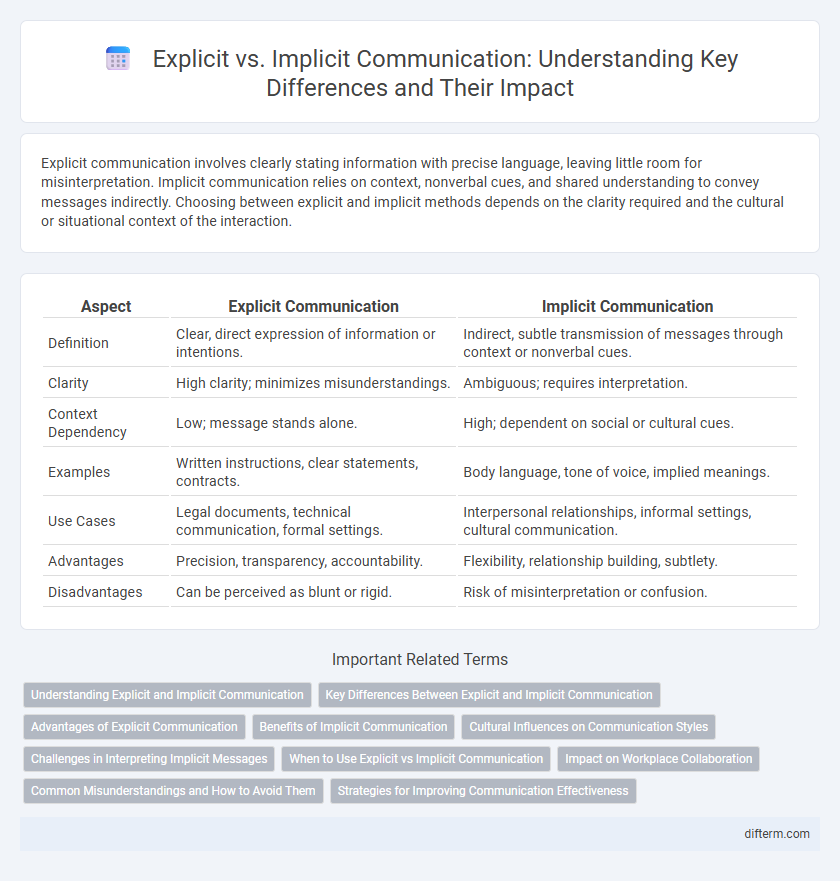Explicit communication involves clearly stating information with precise language, leaving little room for misinterpretation. Implicit communication relies on context, nonverbal cues, and shared understanding to convey messages indirectly. Choosing between explicit and implicit methods depends on the clarity required and the cultural or situational context of the interaction.
Table of Comparison
| Aspect | Explicit Communication | Implicit Communication |
|---|---|---|
| Definition | Clear, direct expression of information or intentions. | Indirect, subtle transmission of messages through context or nonverbal cues. |
| Clarity | High clarity; minimizes misunderstandings. | Ambiguous; requires interpretation. |
| Context Dependency | Low; message stands alone. | High; dependent on social or cultural cues. |
| Examples | Written instructions, clear statements, contracts. | Body language, tone of voice, implied meanings. |
| Use Cases | Legal documents, technical communication, formal settings. | Interpersonal relationships, informal settings, cultural communication. |
| Advantages | Precision, transparency, accountability. | Flexibility, relationship building, subtlety. |
| Disadvantages | Can be perceived as blunt or rigid. | Risk of misinterpretation or confusion. |
Understanding Explicit and Implicit Communication
Explicit communication delivers clear, unambiguous messages through direct language and detailed information, ensuring the recipient comprehends the exact meaning intended without inference. Implicit communication relies on context, tone, body language, and shared knowledge to convey meaning indirectly, often requiring interpretation beyond the spoken words. Effective understanding of these methods enhances interpersonal interactions by balancing clarity with subtlety, adapting to cultural and situational nuances.
Key Differences Between Explicit and Implicit Communication
Explicit communication uses clear, direct language to convey precise messages, reducing the risk of misunderstandings. Implicit communication relies on context, non-verbal cues, and inferred meanings, often requiring higher interpretation skills. Understanding the differences enhances interpersonal effectiveness and prevents communication breakdowns in professional and personal settings.
Advantages of Explicit Communication
Explicit communication ensures clarity by conveying messages directly, reducing misunderstandings in professional and personal interactions. It enhances efficiency by providing specific instructions and expectations, which facilitates quicker decision-making and task completion. This approach supports accountability, as clear communication leaves little room for ambiguity or misinterpretation.
Benefits of Implicit Communication
Implicit communication enhances interpersonal understanding by conveying emotions and intentions beyond words, fostering stronger relationships. It allows for efficient, context-rich exchanges that reduce the need for detailed explanations, saving time and cognitive effort. This non-verbal nuance improves collaboration, particularly in high-context cultures where shared knowledge shapes interaction.
Cultural Influences on Communication Styles
Cultural influences shape communication styles by determining the preference for explicit or implicit messaging; high-context cultures like Japan rely heavily on implicit communication, where meaning is derived from context and non-verbal cues. In contrast, low-context cultures such as the United States emphasize explicit communication, valuing direct, clear, and unambiguous language to convey messages. Understanding these cultural differences enhances cross-cultural interactions and reduces miscommunication in global business or social environments.
Challenges in Interpreting Implicit Messages
Interpreting implicit messages often leads to misunderstandings because these messages rely heavily on context, tone, and nonverbal cues that vary across cultures and individuals. The lack of clear, explicit information increases ambiguity, making it difficult for recipients to accurately decode the sender's true intent. These challenges are compounded in digital communication, where visual and auditory signals are frequently absent, heightening the risk of misinterpretation.
When to Use Explicit vs Implicit Communication
Explicit communication is essential in situations requiring clarity, such as legal agreements, technical instructions, or safety protocols, ensuring messages are understood without ambiguity. Implicit communication suits contexts where subtlety and social cues convey meaning, like in personal relationships or cultural traditions. Choosing between explicit and implicit communication depends on the audience's familiarity, the complexity of information, and the potential consequences of misinterpretation.
Impact on Workplace Collaboration
Explicit communication in the workplace enhances clarity, reduces misunderstandings, and fosters efficient collaboration by clearly defining tasks and expectations. Implicit communication relies on shared context and nonverbal cues, which can create confusion or misinterpretations among diverse teams. Prioritizing explicit exchanges improves team alignment, increases productivity, and supports inclusive decision-making.
Common Misunderstandings and How to Avoid Them
Explicit communication clearly conveys the intended message through direct language, reducing the risk of misunderstandings caused by ambiguous or implied meanings. Implicit communication relies on context, tone, and non-verbal cues, which can lead to misinterpretations when assumptions differ between sender and receiver. To avoid common misunderstandings, individuals should prioritize clarity by using explicit language and verify comprehension through active feedback.
Strategies for Improving Communication Effectiveness
Clear communication benefits from explicitly stating intentions, expectations, and feedback to minimize misunderstandings and ensure all parties share a common understanding. Employing active listening techniques and asking clarifying questions enhances the interpretation of implicit messages and uncovers underlying meanings. Adopting consistent nonverbal cues and confirming comprehension through paraphrasing strengthens message clarity and fosters trust in interpersonal exchanges.
explicit vs implicit Infographic

 difterm.com
difterm.com